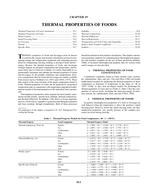Description
Thermal properties of foods and beverages must be known to perform the various heat transfer calculations involved in designing storage and refrigeration equipment and estimating process times for refrigerating, freezing, heating, or drying of foods and beverages. Because the thermal properties of foods and beverages strongly depend on chemical composition and temperature, and because many types of food are available, it is nearly impossible to experimentally determine and tabulate the thermal properties of foods and beverages for all possible conditions and compositions. However, composition data for foods and beverages are readily available from sources such as Holland et al. (1991) and USDA (1975). These data consist of the mass fractions of the major components found in foods. Thermal properties of foods can be predicted by using these composition data in conjunction with temperature-dependent mathematical models of thermal properties of the individual food constituents.
Thermal Properties of Food Constituents
Thermal Properties of Foods
Water Content
Initial Freezing Point
Ice Fraction
Density
Specific Heat
Enthalpy
Thermal Conductivity
Thermal Diffusivity
Heat of Respiration
Transpiration of Fresh Fruits and Vegetables
Surface Heat Transfer Coefficient
Symbols
ISBN: 978-1-939200-98-3 (for SI versions of chapters)
ISSN: 1930-7217 (for SI versions of chapters)
Citation: 2018 ASHRAE Handbook–Refrigeration
Product Details
- Published:
- 2018
- ISBN(s):
- 9781939200983
- Number of Pages:
- 31
- Units of Measure:
- SI
- File Size:
- 1 file , 730 KB
- Product Code(s):
- D-R192018SI




